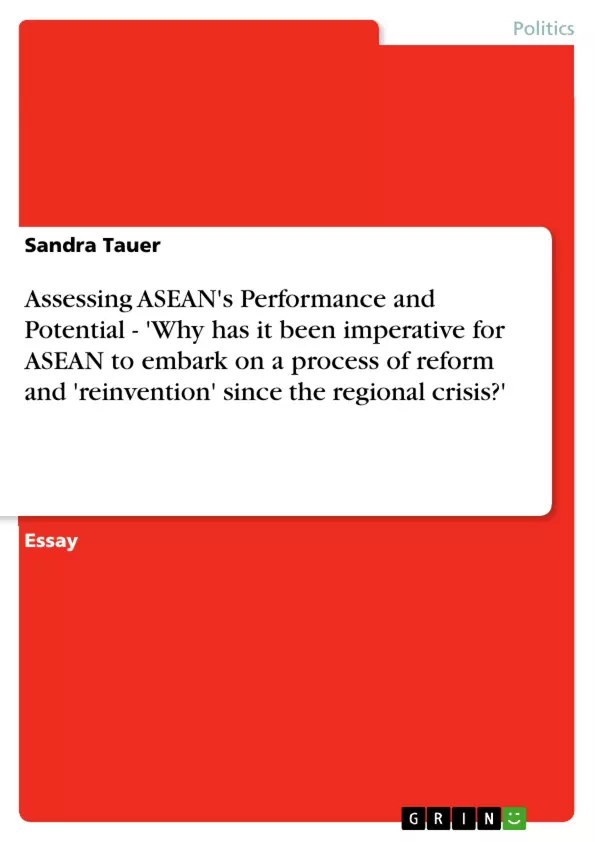Singapore’s Prime Minister Goh Chok Tong opened the 6thSummit of the Association of Southeast Asian Nations (ASEAN) in Hanoi with the words: "This has been a traumatic year for ASEAN members." Indeed, the financial crisis of 1997 marked the end of an extraordinary decade of internationally oriented economic growth throughout Southeast Asia, and came as a shock for the Southeast Asian countries. Although Paul Krugman had warned that Asian growth, like that of the Soviet Union in its high-growth era, seemed to be driven by extraordinary growth in inputs like labour and capital rather than by gains in efficiency, his was a lone voice in academic discussion. The severity of the crisis inevitably raised the question of how it would affect ASEAN. Ross Garnaut commented that the largest long-term effect of the crisis would be its effect on policy formulation.
Since its formation in 1967, ASEAN has occupied a central role in the international relations of Southeast Asia.5It was the first regional organization in Asia, and is a crucial factor in East Asian and Asia-Pacific regionalism. From the beginning, ASEAN’s mission was regional resilience against great power interests. Economic development in the region was perceived as means to ward off communist and ethnic rebellions. However, after three decades of promoting peaceful intra-regional relations, ASEANone of the most successful regional organizations in the developing world-has needed to seriously reinvent itself since 1997. As the Deputy Prime Minister of Singapore, Shanmugam Jayakumar, noted in April 2006: “we have to rethink and remake ASEAN”. According to Jayakumar, ASEAN has to deepen and accelerate the process of integration to stay competitive in the face of the challenges confronting the regional grouping, or face the risk of being marginalised. Furthermore, he claimed that ASEAN must adopt a different paradigm with both bold and practical ideas for the future.
This essay will examine four reasons why ASEAN must redefine its future aims, strategies and paths. The first part deals with its failure to react to the financial crisis, while the second outlines its norms, especially non-interference. Parts three and four analyse external factors: the rise of China, the emergence of East Asian regionalism and other geopolitical factors.
Inhaltsverzeichnis (Table of Contents)
- Introduction
- I. Failure to react to the financial crisis
- II. Ineffectiveness of the 'ASEAN-way'
- III. ASEAN's view on China
- IV. Emergence of East-Asia regionalism and geopolitical factors
- Conclusion
Zielsetzung und Themenschwerpunkte (Objectives and Key Themes)
This essay examines the reasons why ASEAN must redefine its future aims, strategies, and paths in response to the 1997 financial crisis. The essay analyzes the organization's shortcomings in reacting to the crisis, specifically its failure to provide collective support and its adherence to non-interference principles. It also explores external factors, such as the rise of China and the emergence of East Asian regionalism, which necessitate a reevaluation of ASEAN's role in the region.
- ASEAN's response to the 1997 financial crisis
- The effectiveness of ASEAN's 'non-interference' policy
- The impact of China's rise on ASEAN
- The influence of East Asian regionalism on ASEAN
- The need for ASEAN to redefine its future aims and strategies
Zusammenfassung der Kapitel (Chapter Summaries)
- Introduction: The essay sets the context for the discussion by outlining the impact of the 1997 financial crisis on ASEAN and the subsequent call for reform. It also briefly outlines the organization's historical background and its original mission of promoting regional resilience.
- I. Failure to react to the financial crisis: This section examines ASEAN's inability to provide effective support to its members during the financial crisis. It highlights the lack of cooperation and the differing responses of individual member states, showcasing the limitations of regional capabilities.
- II. Ineffectiveness of the 'ASEAN-way': This section analyzes the "ASEAN-way" principle of non-interference and its implications for the organization's ability to address regional challenges, particularly in the context of the financial crisis.
- III. ASEAN's view on China: This section discusses ASEAN's perspective on the rise of China and its impact on the regional dynamics, exploring the challenges and opportunities presented by China's increasing influence in the region.
- IV. Emergence of East-Asia regionalism and geopolitical factors: This section examines the emergence of East Asian regionalism, including the role of geopolitical factors, and its influence on ASEAN's future direction. It explores how ASEAN must navigate this evolving regional landscape.
Schlüsselwörter (Keywords)
Key words and focus topics of this essay include ASEAN, regionalism, financial crisis, non-interference, East Asia, China, geopolitical factors, and regional integration.
- Citar trabajo
- M.A. Sandra Tauer (Autor), 2006, Assessing ASEAN's Performance and Potential - 'Why has it been imperative for ASEAN to embark on a process of reform and 'reinvention' since the regional crisis?', Múnich, GRIN Verlag, https://www.grin.com/document/62817



